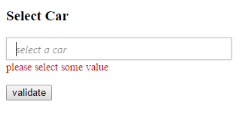How To Section in AngularJS Autocomplete
19 Dec 202210 minutes to read
Set Client Side Validation for Autocomplete?
Since the Autocomplete is a form control, we can set the validation for Autocomplete on form submission. We can use the e-validationrules property to set the validation rules and e-validationmessage property to display the error message on form validation.
NOTE
jquery.validate.min script file should be referred for validation, for more details, referhere.
<!DOCTYPE html>
<html lang="en" ng-app="AutoCompleteApp">
<head>
<title>Essential Studio for JavaScript : AngularJS Support for Autocomplete</title>
<!-- Style sheet for default theme (flat azure) -->
<link href="http://cdn.syncfusion.com/14.4.0.15/js/web/default-theme/ej.web.all.min.css" rel="stylesheet" />
<!--Scripts-->
<script src="http://cdn.syncfusion.com/js/assets/external/jquery-3.1.1.min.js" type="text/javascript"> </script>
<script src="http://cdn.syncfusion.com/js/assets/external/jquery.validate.min.js" type="text/javascript"> </script>
<script src="http://cdn.syncfusion.com/js/assets/external/angular.min.js"></script>
<script type="text/javascript" src="http://cdn.syncfusion.com/14.4.0.15/js/web/ej.web.all.min.js "></script>
<script src="http://cdn.syncfusion.com/14.4.0.15/js/common/ej.widget.angular.min.js"></script>
<!--Add custom scripts here -->
</head>
<body ng-controller="AutocompleteCtrl">
</html><form id="form1">
<h3>Select Car</h3>
<input type="text" ej-autocomplete e-dataSource="dataList" e-multiSelectMode="multiselect" e-width="300" e-validationrules="validRules" e-validationmessage="validMessage" e-watermarktext="select a car" />
<input type="submit" value="validate" id="btn" />
</form><script type="text/javascript">
$.validator.setDefaults({
ignore: [],
errorClass: 'e-validation-error',
errorPlacement: function (error, element) {
$(error).insertAfter(element.closest(".e-widget"));
}
// any other default options and/or rules
});
angular.module('AutoCompleteApp', ['ejangular'])
.controller('AutocompleteCtrl', function ($scope) {
$scope.dataList = carList;
$scope.validRules = {
required: true
};
$scope.validMessage = {
required: "please select some value"
}
});
</script>
NOTE
jQuery predefined error messages to that annotation attribute will be shown when this property is not defined. The below given example explain this behavior of ‘required’ attribute.
Get the key value of the selected item?
By default, the selected item’s key value will be maintained in the e-selectvaluebykey model value. If we take the instance of the autocomplete and in the model, the selected value’s key will be maintained in the e-selectvalueBykey property.
<input type="text" ej-autocomplete e-datasource="dataList" e-fields-key="key" e-fields-text="text" e-selectvaluebykey="keyValue" e-width="30%" />
<script type="text/javascript">
var countriesField = [
{ name: "Austria", index: "C1" },
{ name: "Australia", index: "C2" }, { name: "Antarctica", index: "C3" },
{ name: "Bangladesh", index: "C4" }, { name: "Belgium", index: "C5" },
{ name: "Brazil", index: "C6" },
{ name: "Canada", index: "C7" }, { name: "China", index: "C8" },
{ name: "Cuba", index: "C9" },
{ name: "Denmark", index: "C10" }, { name: "Dominica", index: "C11" },
{ name: "Europe", index: "C12" }, { name: "Egypt", index: "C13" },
{ name: "England", index: "C14" },
{ name: "India", index: "C15" }, { name: "Indonesia", index: "C16" }
];
angular.module('AutoCompleteApp', ['ejangular'])
.controller('AutocompleteCtrl', function ($scope) {
$scope.dataList = countriesField;
$scope.key="index";
$scope.text="name";
$scope.keyValue = "C6";
});
</script>
But when using the remote datasource, we cannot able to maintain the key value in the e-selectvaluekey model property. Hence in that case we can use the e-select property to get the key value in the select event’s argument.
<input type="text" ej-autocomplete e-datasource="dataList" e-query="query" e-fields-key="key" e-fields-text="text" e-select="onSelect" e-width="205" />
<script type="text/javascript">
var dataManger = ej.DataManager({
url: "http://mvc.syncfusion.com/Services/Northwnd.svc/"
});
var query = ej.Query().from("Suppliers").select("SupplierID", "ContactName");
angular.module('AutoCompleteApp', ['ejangular'])
.controller('AutocompleteCtrl', function ($scope) {
$scope.dataList = dataManger;
$scope.query=query;
$scope.key="SupplierID";
$scope.text="ContactName";
$scope.onSelect= function (args){
// Get the key here
myKey= args.key;
}
});
</script>